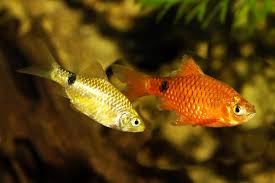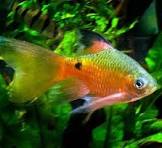Barb-Rosy
Barb-Rosy
check_circle Fast Shipping
check_circle Quality Products
check_circle Affordable Price
Reach out to us on ''available to order'' items via WhatsAp or email
Low stock: 10 left
Couldn't load pickup availability

Barb-Rosy
package_2
Product Description
Product Description
All our fish, shrimp and corals are bagged with fresh oxygen as well as a heat pack in winter.
When ordering livestock please select the box size and add it to your cart for accurate overnight (1-2 days) shipping costs. A small box can take 1-2 bags and a medium box 6 bags. One bag fits max 10 small (1-3cm) fish or max 2 medium (3-5cm) fish or max 1 large (>5cm) fish.
ONE SPECIES PER BAG. Eg: One bag of 10 neon tetra.
Rosy Barb (Puntius conchonius)
Description:
-
Appearance:
- Body: Medium-sized and robust, with a streamlined, torpedo-like shape.
- Color: Males typically exhibit a bright rosy or pinkish-red coloration, especially during breeding periods. Females are generally more subdued, with a more yellowish or light brown color.
- Fins: Fins are usually clear or lightly tinted, often with a touch of red or orange.
- Size: Typically grows to about 3-4 inches (7.5-10 cm) in length.
-
Behavior:
- Activity: Active and energetic, often seen swimming energetically and exploring the tank.
- Social Structure: Prefers to be kept in groups to exhibit natural schooling behavior, which helps reduce stress and promote natural behaviors.
Care Requirements:
-
Tank Size:
- Minimum of 20 gallons (76 liters) for a small group; larger tanks are better for more stable conditions and to accommodate their active nature.
-
Water Parameters:
- Temperature: 72-78°F (22-26°C).
- pH: 6.0-7.5.
- Hardness: Soft to moderately hard water.
- Filtration: Good filtration is important to maintain clean water, but strong currents should be avoided as they can stress the fish.
-
Tank Setup:
- Substrate: Soft substrate like sand or fine gravel is ideal.
- Aquascaping: Provide ample swimming space with a well-planted tank. Use plants, driftwood, and rocks to create hiding spots and visual barriers.
- Cover: A covered tank is advisable to prevent jumping, as Rosy Barbs can occasionally leap out of the water.
-
Diet:
- Primary Food: Omnivorous; feed a varied diet including high-quality pellets, flakes, and live or frozen foods such as brine shrimp, daphnia, and bloodworms.
- Supplemental Food: Offer occasional vegetable matter like spirulina or blanched vegetables to ensure balanced nutrition.
-
Behavioral Considerations:
- Compatibility: Generally peaceful but can be nippy towards fish with long fins or slow-moving species. Best kept with other small, active fish. Avoid aggressive or very large tank mates.
- Social Behavior: Thrives in schools of 6 or more. They may become stressed or less active if kept alone or in very small groups.
-
Tank Maintenance:
- Water Changes: Perform regular water changes (20-30% weekly) to maintain water quality and prevent the buildup of toxins.
- Cleaning: Regularly clean the tank and remove any uneaten food or waste to maintain a healthy environment.
-
Health Care:
- Observation: Watch for signs of stress or illness, such as changes in behavior, loss of appetite, or visible symptoms like spots or lesions.
- Treatment: Ensure optimal water conditions and consult an aquarium professional if any health issues arise.




